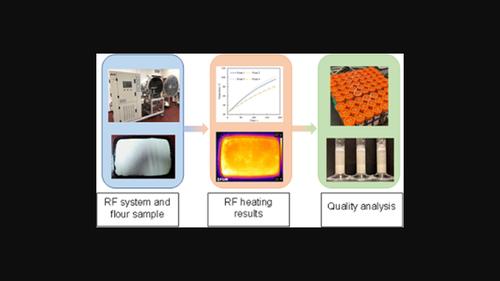当前位置:
X-MOL 学术
›
J. Food Process Eng.
›
论文详情
Our official English website, www.x-mol.net, welcomes your
feedback! (Note: you will need to create a separate account there.)
Quality analysis of all-purpose wheat flour pasteurized with radiofrequency-assisted hot air heating
Journal of Food Process Engineering ( IF 2.7 ) Pub Date : 2022-06-20 , DOI: 10.1111/jfpe.14104 Qianyi Chen 1 , Tao Wu 1 , Mark T. Morgan 1 , Jiajia Chen 1
Journal of Food Process Engineering ( IF 2.7 ) Pub Date : 2022-06-20 , DOI: 10.1111/jfpe.14104 Qianyi Chen 1 , Tao Wu 1 , Mark T. Morgan 1 , Jiajia Chen 1
Affiliation

|
Radiofrequency (RF) is a promising technology for preheating wheat flour for pasteurization but may influence its quality and functional properties. This study evaluated the quality and functionality change of bleached and unbleached, all-purpose wheat flours after treating with RF and/or extended hot air heating at three processing temperatures (80, 85, and 90°C). The moisture content, color, sodium dodecyl sulfate (SDS) sedimentation test, flour swelling power, and solvent retention capacity (SRC) tests were measured. The moisture content of both bleached and unbleached samples decreased after the RF treatment, and the extended hot air heating further increased the moisture loss. The ΔE values of color change were less than two for all processing conditions, indicating little color change. The SDS results showed that the sedimentation volumes decreased after the thermal treatments, indicating decreased relative gluten strength. The flour swelling power increased after the RF and the extended hot air heating. The SRC tests measured the flour retention in four different solvents of 5% lactic acid, 5% sodium carbonate, 50% sucrose, and water, and their values were within the reported ranges of a variety of flour samples. The gluten performance index calculated from the four SRC values decreased after RF and extended hot air heating. The results showed that most heating conditions significantly changed the overall quality of flour samples, statistically (p < 0.05). However, the absolute changes of the values were small and within ranges of the reported values. Thus, the RF-assisted pasteurization may not influence the practical applications of the treated flour for different flour-based products.
中文翻译:

射频辅助热风加热巴氏杀菌通用小麦粉的品质分析
射频 (RF) 是一种用于预热小麦粉进行巴氏杀菌的有前途的技术,但可能会影响其质量和功能特性。本研究评估了漂白和未漂白通用小麦粉在三种加工温度(80、85 和 90°C)下经射频处理和/或延长热空气加热后的质量和功能变化。测量水分含量、颜色、十二烷基硫酸钠 (SDS) 沉降试验、面粉溶胀力和溶剂保持能力 (SRC) 试验。RF 处理后漂白和未漂白样品的水分含量均降低,而延长的热空气加热进一步增加了水分损失。对于所有处理条件,颜色变化的ΔE值都小于2,表明颜色变化很小。SDS 结果表明,热处理后沉降体积减小,表明相对面筋强度降低。射频和延长热风加热后面粉膨胀力增加。SRC 测试测量了面粉在 5% 乳酸、5% 碳酸钠、50% 蔗糖和水的四种不同溶剂中的保留率,它们的值在各种面粉样品的报告范围内。从四个 SRC 值计算的面筋性能指数在射频和延长热空气加热后下降。结果表明,大多数加热条件显着改变了面粉样品的整体质量,统计学上(SRC 测试测量了面粉在 5% 乳酸、5% 碳酸钠、50% 蔗糖和水的四种不同溶剂中的保留率,它们的值在各种面粉样品的报告范围内。从四个 SRC 值计算的面筋性能指数在射频和延长热空气加热后下降。结果表明,大多数加热条件显着改变了面粉样品的整体质量,统计学上(SRC 测试测量了面粉在 5% 乳酸、5% 碳酸钠、50% 蔗糖和水的四种不同溶剂中的保留率,它们的值在各种面粉样品的报告范围内。从四个 SRC 值计算的面筋性能指数在射频和延长热空气加热后下降。结果表明,大多数加热条件显着改变了面粉样品的整体质量,统计学上(p < 0.05)。但是,这些值的绝对变化很小,并且在报告值的范围内。因此,射频辅助巴氏杀菌可能不会影响处理过的面粉在不同面粉产品中的实际应用。
更新日期:2022-06-20
中文翻译:

射频辅助热风加热巴氏杀菌通用小麦粉的品质分析
射频 (RF) 是一种用于预热小麦粉进行巴氏杀菌的有前途的技术,但可能会影响其质量和功能特性。本研究评估了漂白和未漂白通用小麦粉在三种加工温度(80、85 和 90°C)下经射频处理和/或延长热空气加热后的质量和功能变化。测量水分含量、颜色、十二烷基硫酸钠 (SDS) 沉降试验、面粉溶胀力和溶剂保持能力 (SRC) 试验。RF 处理后漂白和未漂白样品的水分含量均降低,而延长的热空气加热进一步增加了水分损失。对于所有处理条件,颜色变化的ΔE值都小于2,表明颜色变化很小。SDS 结果表明,热处理后沉降体积减小,表明相对面筋强度降低。射频和延长热风加热后面粉膨胀力增加。SRC 测试测量了面粉在 5% 乳酸、5% 碳酸钠、50% 蔗糖和水的四种不同溶剂中的保留率,它们的值在各种面粉样品的报告范围内。从四个 SRC 值计算的面筋性能指数在射频和延长热空气加热后下降。结果表明,大多数加热条件显着改变了面粉样品的整体质量,统计学上(SRC 测试测量了面粉在 5% 乳酸、5% 碳酸钠、50% 蔗糖和水的四种不同溶剂中的保留率,它们的值在各种面粉样品的报告范围内。从四个 SRC 值计算的面筋性能指数在射频和延长热空气加热后下降。结果表明,大多数加热条件显着改变了面粉样品的整体质量,统计学上(SRC 测试测量了面粉在 5% 乳酸、5% 碳酸钠、50% 蔗糖和水的四种不同溶剂中的保留率,它们的值在各种面粉样品的报告范围内。从四个 SRC 值计算的面筋性能指数在射频和延长热空气加热后下降。结果表明,大多数加热条件显着改变了面粉样品的整体质量,统计学上(p < 0.05)。但是,这些值的绝对变化很小,并且在报告值的范围内。因此,射频辅助巴氏杀菌可能不会影响处理过的面粉在不同面粉产品中的实际应用。









































 京公网安备 11010802027423号
京公网安备 11010802027423号